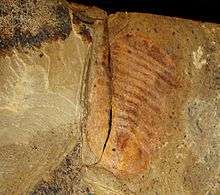Retifacies
Retifacies ( Retifacies abnormalis ) is an extinct arthropod, that lived in the lower Cambrian (about 520 million years ago). Its fossil remains have been found in China, in the well-known Maotianshan Shales
| Retifacies | |
|---|---|
 | |
| Scientific classification | |
| Kingdom: | Animalia |
| Phylum: | Arthropoda |
| (unranked): | †Artiopoda |
| Genus: | †Retifacies Hou et al. 1989 |
| Species: | †R. abnormalis |
| Binomial name | |
| †Retifacies abnormalis Hou et al. 1989 | |
Description
Of considerable size compared to that of other primitive arthropods, this animal could reach 12 centimeters in length, even though most of the specimens found were smaller. The cephalic shield was short, and was followed by a dozen tergites that overlapped each other. The rear part of the body consisted of a large shield and a long segmented tail. All the tergites had a surface made up of irregular polygons, unknown among other Maotianshan arthropods.
Ventrally there were two eyes placed on peduncles, and immediately alongside there were two long antennae with short bristles. Like many primitive arthropods, this animal also had the classic biramous appendages, eighteen pairs in number. Three of these were positioned under the head, ten corresponded to the thoracic wipes and five were present in the caudal shield. The appendages consisted of a branch with ambulatory function (endopodium) with a thorny internal margin, and a branch - gill (exopodium) formed by a fin-shaped structure, consisting of twenty bristles.
Classification
The vaguely similar appearance to that of a trilobite originally led scholars to think that Retifacies was a possible relative of Helmetia or Naraoia , two other primitive arthropods related to trilobites (Delle Cave and Simonetta 1991, Hou and Bergstrom 1997). Subsequently, another study on arachnomorph Cambrian showed how Retifacies was related to other basal arthropods, as Emeraldella and Sidneyia , from the field of Burgess Shales in Canada, as part of Artiopoda, a placement that has been confirmed in subsequent studies.
Lifestyle
Like many other Cambrian arthropods, Retifacies probably lived crawling on the seabed, the fossils do not retain any noteworthy cephalic appendage, the serrated edge of the legs suggests that this animal was a predator or a scavenger. The possible presence of sediment in the intestine of a specimen (Hou and Bergstrom 1997) suggests that Retifacies may have used other strategies for feeding.
References
- Hou, Chen & Lu, 1989. Early Cambrian new arthropods from Chengjiang, Yunnan. Acta Palaeontologica Sinica, 28, 42-57.
- Chen & Zhou, 1997. Biology of the Chengjiang fauna. Bulletin of the Natural Museum of Natural Science, 10, 11 – 106.
- Hou & Bergstrom, 1997. Arthropods of the Lower Cambrian Chengjiang fauna, southwest China. Fossils and strata, 45, 116 pp.
- Edgecombe & Ramskold, 1999b. Relationships of Cambrian Arachnata and the systematic position of Trilobita. Journal of Paleontology, 73, 263 – 287.
- Hou, Bergstrom, Wang, Feng & Chen, 1999. The Chengjiang fauna. Exceptionally well-preserved animals from 530 million years ago. 170 pp. Yunnan Science and Technology Press, Kunming, Yunnan Province, China.